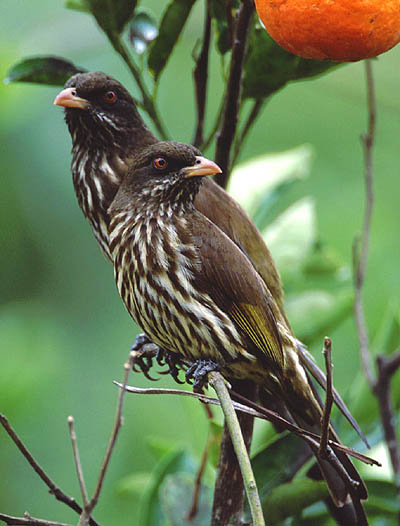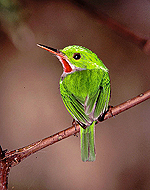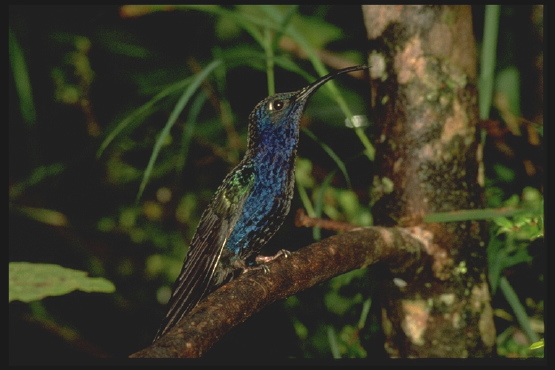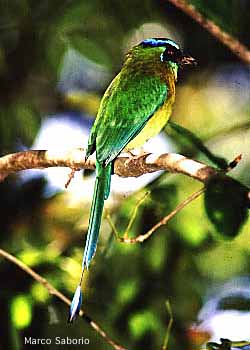 The Dominican Republic's national bird, the Palm Chat(endemic)
Photo by Eladio Fernandez.
The Dominican Republic's national bird, the Palm Chat(endemic)
Photo by Eladio Fernandez.This page has information and useful tools for birdwatching especially in the following locations: the Dominican Republic, Central America (Costa Rica, Nicaragua and Panama), Ecuador, Peru, Venezuela, and the Yucatán Peninsula of Mexico.
This island nation has a diverse ecosystem and many interesting bird species. As part of the West Indies, there are about 20 regional endemics. Also there are about 30 endemic species found only on this island. There are many common North American species found here as well. A total of nearly 300 species are found here, including casuals and vagrants. We have seen about 190 of these species so far. An active ornithological society and birding club is made up of mostly dominicans and some ex-pats. Check them out - Ornithological Society of Hispaniola Web Page
and the Ornithological Society of Hispaniola Yahoo Group Page
Also check out our "other web page" dedicated to Dominican birds - lots more photos and detailed information, including specific locations. Birdwatching in the Dominican Republic / observando aves en la Republica Dominicana
The best places to birdwatch are:
1. Jardin Botanico (Botanical Garden) in Santo Domingo for ease and accessability. A surprising number of birds considering its urban setting.
 The Dominican Republic's national bird, the Palm Chat(endemic)
Photo by Eladio Fernandez.
The Dominican Republic's national bird, the Palm Chat(endemic)
Photo by Eladio Fernandez.
Even the Hispaniolan Parakeet, the endemic aratinga species, is found throughout the country, and easily seen in the capital city of Santo Domingo. If you want more photos, PLEASE check out: Eladio's site for more GREAT photos and info on birding tours to the DR.
2. The Sierra de Bahoruco National Park, accessed from Duverge on the north and Pedernales on the south, in the Barahona province. By far the best region for birding, with almost all the endemics able to found there.
 The Hispaniolan Trogon "El Papagayo" Photos by Eladio Fernandez (Bahoruco Mts.)
The Hispaniolan Trogon "El Papagayo" Photos by Eladio Fernandez (Bahoruco Mts.)

3. The area around Constanza and Jarabacoa in the central mountain range: many options for birding in a beautiful lush and temperate climate.
4. Los Haitises National Park, in the eastern part of the country: shore area, mangroves, lush rainforest and rugged terrain make this good birding.

The Ridgway's Hawk, a rare, endangered endemic Buteo, found exlusively in the Los Haitises area.Photo by Eladio Fernandez.
 The Broad-billed Tody, endemic, found in wooded areas at low and medium elevations. It's a real gem! Photo by Eladio Fernandez.
The Broad-billed Tody, endemic, found in wooded areas at low and medium elevations. It's a real gem! Photo by Eladio Fernandez.
We are long term residents of this country and can also help you arrange your birding trip. A "must-have": The new Guide to the Birds of the Dominican Rep. & Haiti, by Steven Latta et.al., published by Princeton U. Press.
Take a look at our checklists to whet your appetite.
Birdwatcher's Checklist for the Dominican Republic List of Endemics and Regional Endemics for the DR
Costa Rica can be called a birders paradise. 850 species of birds in a country the size of West Virginia!
The Violet Sabrewing hummingbird is a large spectacular hummer found in middle and high elevations in Costa Rica.
 (photo from another internet site - write us for more info - stevebrauning@yahoo.com )
(photo from another internet site - write us for more info - stevebrauning@yahoo.com )
Many people have heard of the Resplendent Quetzal, found in the highland cloud forests of throughout Central America; Costa Rica is the best place to find this bird.
We really enjoyed the year and a half we lived there, and made the most of birding opportunities. We were able to indentify 476 species in total. Here are some of our favorite places :
1. Caribbean coast: Tortuguero in the north and Cahuita/Talamanca in the south.
2. Caribbean foothills: La Selva reserve is unparalleled for variety of birds; also Arenal volcano region is great.
(You can get 100 species a day EASY in either place!)Tons of toucans and tanagers!!!
3. Highlands: Monteverde is a big tourist spot, but yet unspoiled. Out of the way San Geraldo de Dota farther south is great too. Quetzals can be easily seen there. Also the Blue-crowned Motmot is quite common throughout the mid and high elevations, even in San Jose itself. The Blue-crowned Motmot - photo from the internet

4. Dry Pacific West and Northwest region: many unique birds to see there. Samara beach is a great place to go for sun, sand and birds! Also La Pacifica ranch, and Hacienda Solimar.
We can recommend places to stay and contacts for most all of these places. Take a look at our travelog from our most recent stay there(Feb.-Aug. 2000).
Resource: A Guide to the Birds of Costa Rica, by Stiles, Skutch, and Gardner, published by Cornell.
Checklist for the Birds of Costa Rica
Panama , neighbor to the south and east of Costa Rica, with it's other border on Colombia, shares many characteristics of C.R. But the advantage is that much of best birding is within short drives of capital, Panama City. All along the canal, on the east side, there are well known spots: Semaphore Hill with it's Canopy Tower lodge; Pipeline Road; Gamboa. Also, not far across the big bridge to the west of P.C. is Cerro Campana, with cloud forest and middle elevations. Farther in each direction are more remote areas: the vast lowland jungles of the Darien to the east, and the highlands of Chirripo to the west. We can provide some contacts and some ideas of places to go, based upon ou r experience of birding there. Resource: The Birds of Panama
Nicaragua to the north of Costa Rica has two very different coasts: the dry Pacific and the wet Caribbean. In the middle are medium height mountains. The country's tourism nickname, "The Land of Lakes and Volcanoes" is very approriate, and these 2 features are good attractions for birders. But the infrastructure is not very developed and Ecological Tourism is just starting to take off. Near Managua, one can visit several volcanoes that are national parks. Also several private reserves are easily accessible. The more remote regions, like the northern highlands and the lowland Rio San Juan in the south east, are opening up and are very rich in bird life. We can provide some contacts and ideas of places to go birding, based upon our brief birding experiences there.
We have birded in Guatemala and Honduras also, but very minimally and we do not have any contacts in those countries.
The Yucatan Peninsula, in the extreme south east of Mexico, is another ideal place neotropical birding. It has many interesting tropical species and quite a few endemics. It also is very accessible for visitors, with a large tourist industry, active birding and conservation contacts, as well as other interesting draws(Mayan culture and ruins, colonial culture and architecture, beaches, caves, etc.). The Keel-billed Toucan, made famous by Froot Loops, is found in the jungles of the Caribbean coast and inland.(photo from another internet site)

We have made several visits and were thrilled with the birding. The ideal places we know of are:
1. Caribbean coast: North: Islas Contoy & Mujeres. Farther south, the grounds of the ruins of Tulum were very productive to bird. The huge Siam Kan reserve is as good as it is inaccessible. Near there though, you can drive into Punta Allen, for nice coastal birding. Follow the coastal highway further south, look for wetland areas(Bacalar, esp.).
2. Inland, south: Xpujil area, along roads and in small ruins sites are great for birding: the Calakmul ruins are awesome archeology and birding. A must.
We would be happy to give you some tips and help you arrange your visit.
Checklist for the Birds of the Yucatan Peninsula of Mexico
Ecuador: (coming soon)
Peru: Birding Peru with Kolibri Expeditions
Venezuela: (coming soon)
Return to Steve & Sandra's main page
Thanks for coming by!  hits since Sept. 7, 2005
hits since Sept. 7, 2005